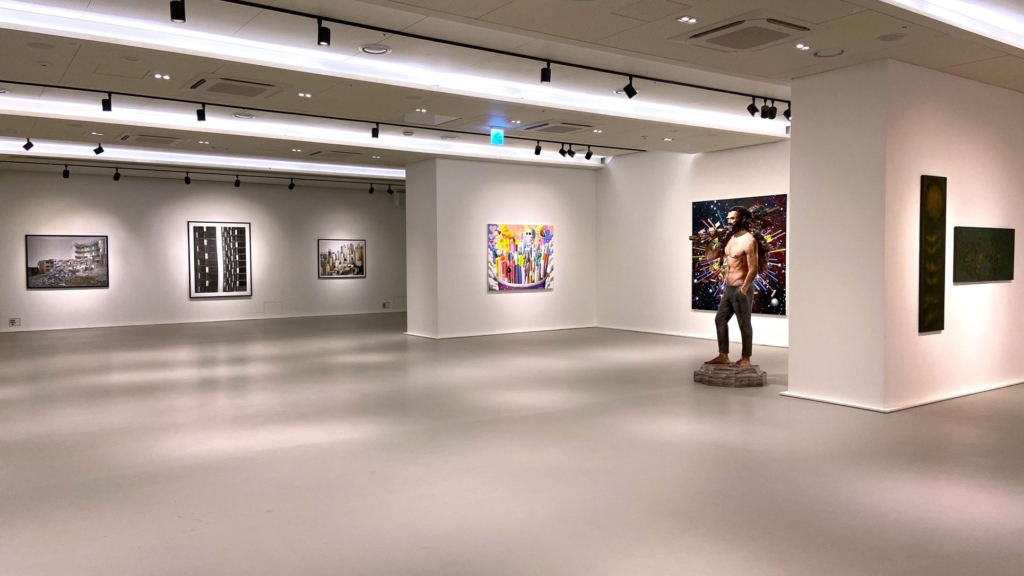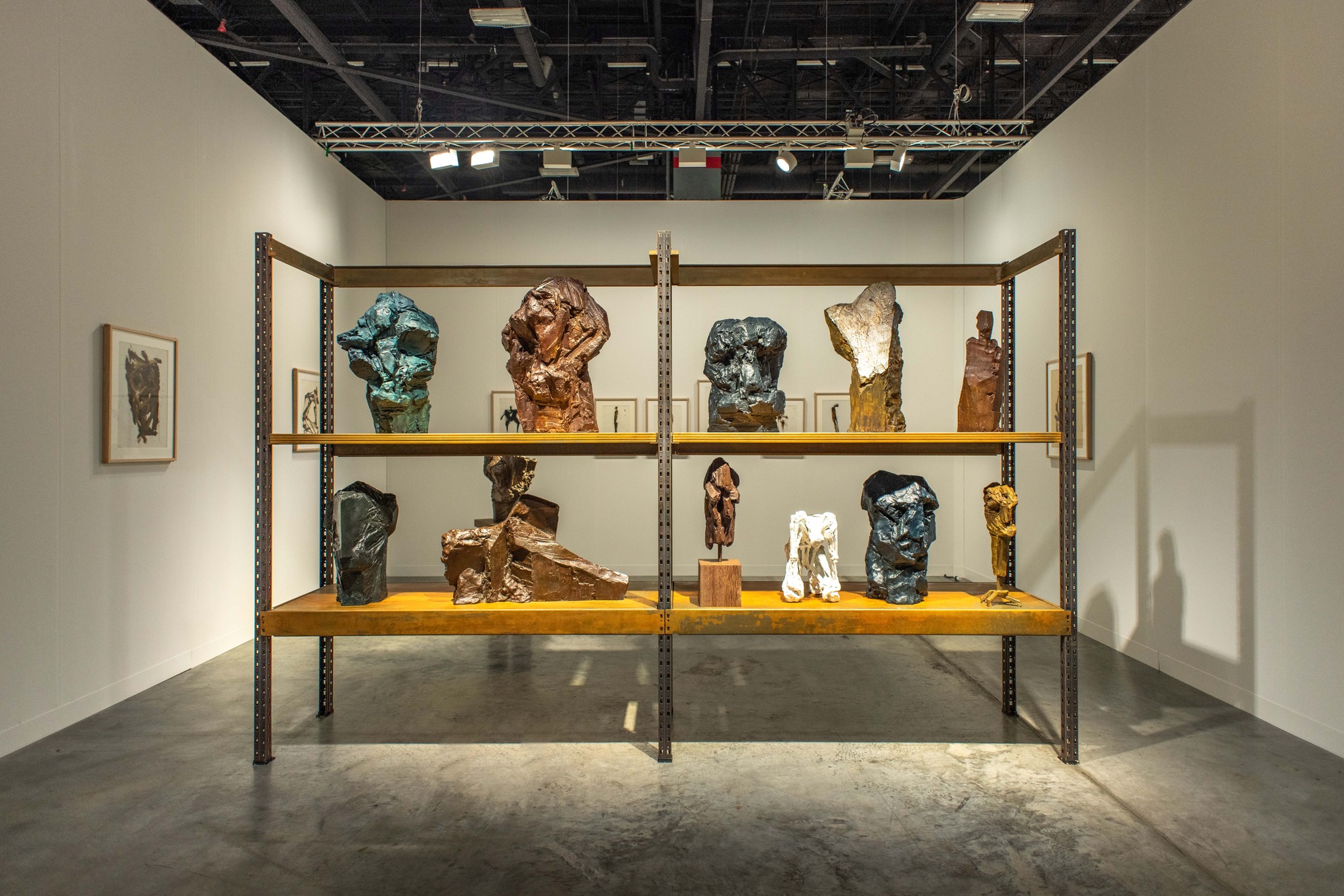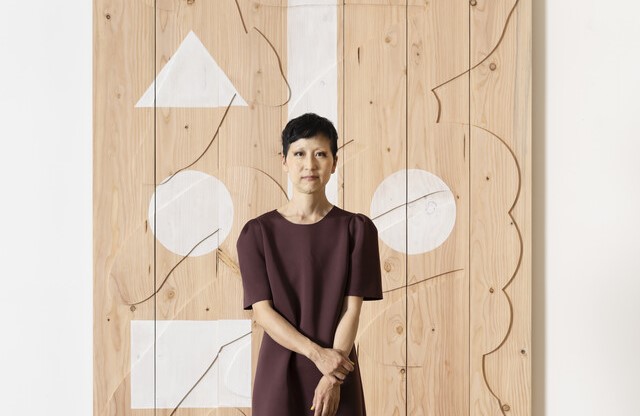Lee Dongwook (b. 1976) focuses on the
images found in the objects surrounding him, combining these with small,
intricate sculptures. His works, where objects and sculptures are intricately
connected, are deeply intertwined with our daily lives and reality.
The choice of media, such as Sculpey (a
type of clay), fossils, and industrial products, alongside his unique
expressive style, reflects the artist's personal taste and private experiences.
However, the content often emerges from a serious observation of individuals in
contemporary society or a sharp critique of reality.

Lee Dongwook, Sailor, 2004 ©Arario Museum
Starting from his university years, Lee Dongwook began combining small plastic model kits with Sculpey, a material often used in clay animation, to create miniature human-shaped sculptures. Since the early 2000s, the artist began to focus on the images featured in the designs of mass-produced goods, such as canned products, and explored how these could be integrated with his small sculptures.

Lee Dongwook, Green Giant, 2003-2004 ©MMCA
In
particular, he pays attention to the images on product designs that are
unrelated to the actual contents of the goods. For instance, his work
Green Giant (2003–2004) was inspired by the American canned
corn product "Green Giant Niblets Corn." Rather than the corn kernels
inside, Lee was drawn to the prominent image of the green giant depicted on the
packaging.
Using
Sculpey, he transformed the flat image of the green giant into a
three-dimensional form and placed it inside the can, replacing the corn
kernels. By humorously inserting a character designed to entice consumption
into the actual product, Lee cleverly critiques the commercial manipulation of
imagery over substance.

Lee Dongwook, Dolphin Safe, 2003 ©MMCA
The artist not only draws inspiration from
the images depicted on product packaging but also interprets the accompanying
text literally, transforming it into small sculptural forms. For example, his
work Dolphin Safe (2003), created using a can of tuna, is
based on the "Dolphin Safe" label printed on the can’s surface.
The "Dolphin Safe" label
indicates that the tuna in the can was caught using methods that avoid harming
dolphins, a practice necessitated by tuna's tendency to swim alongside dolphin
pods. Lee Dongwook focused on how such a label requires contextual knowledge to
be fully understood rather than being immediately intuitive.
The small-sized dolphin sculpture, created
through a literal interpretation of the image suggested by the phrase
"Dolphin Safe," ironically replaces the actual contents of the
product it originated from—tuna—thereby creating a paradoxical situation.

Lee Dongwook, Hooker, 2004 ©DOOSAN Art Center
This
series of works transforms the images or phrases found on the surfaces of
mass-produced consumer goods into three-dimensional forms, intersecting these
with real-world contexts to create surreal and ironic scenes. Meanwhile, Lee
Dongwook’s subsequent works build upon the foundation of his earlier pieces but
take a step further by delving into the essence of human nature.
His
2004 work Hooker features a small human figure shaped into a
fishhook bait, embodying the fragility and imperfection inherent in human
existence. Initiated from a sense of compassion for human beings, the piece
metaphorically reveals the condition of individuals caught in bait-like
circumstances, living lives dictated by forces beyond their own will.
 Lee Dongwook, Good
Boy, 2012 ©DOOSAN Art Center
Lee Dongwook, Good
Boy, 2012 ©DOOSAN Art CenterIn parallel, Lee Dongwook has presented
works exploring the act of "breeding," inspired by his hobbies of
collecting and raising animals. The artist focuses on the power dynamics and
systems of control that operate between the caretaker and the cared-for.
One example is his 2012 work Good
Boy, which depicts a human figure holding the leashes of around 30
dogs. The human, precariously positioned at the center with a leash tied around
his neck, embodies a delicate tension—any slight imbalance threatens to topple
the entire scene.
The title, Good Boy,
ambiguously refers either to the dogs or to the leashed figure at the top of
this hierarchical chain. This ambiguity reflects a scenario where both parties
are mutually entangled in a process of taming each other. It also critiques the
implicit societal structures and unspoken rules upheld by customs and taboos,
revealing an underlying state of constrained order.

Lee Dongwook, Engraved Glory, Indelible Past, 2012 ©Arario Gallery
In
the same year, Lee presented the installation Engraved Glory,
Indelible Past (2012), which replaced human forms with a birdcage,
trophies collected by the artist, and live birds. Inside the large cage,
trophies symbolizing victory and achievement are placed alongside birds that
feed and grow on the seeds stored within the trophies.
Over
time, the once-shiny trophies become tarnished and lose their luster as they
are soiled by the birds' droppings and other debris. This gradual
transformation in Engraved Glory, Indelible Past
metaphorically illustrates the fleeting nature of wealth, fame, and other
dazzling values in human society, revealing the inevitable decline that follows
moments of glory.
 Lee Dongwook, All
the interestings, 2016 ©Perigee Gallery
Lee Dongwook, All
the interestings, 2016 ©Perigee GallerySince 2016, Lee has developed an interest
in “suseok”—an ancient Eastern hobby involving the collection, arrangement, and
appreciation of stones—and has created works inspired by this. The artist
personally collects stones that capture his attention and incorporates them
into installation pieces. While stones used in traditional suseok typically
feature subdued colors, Lee selects stones with vibrant patterns and colors,
showcasing their distinct characteristics.
One example is All the
Interestings (2016), composed of stones gathered from around the
world, intricately stacked and interwoven. Among these stones, materials and
objects from Lee’s previous works also make appearances. The unique individuality
of each vividly patterned stone becomes apparent as they press against one
another, yet their distinctiveness is simultaneously obscured within the
collective arrangement.
 Lee Dongwook, All
the interestings(detail), 2016 ©Perigee Gallery
Lee Dongwook, All
the interestings(detail), 2016 ©Perigee GalleryThrough
such ambiguous installations, the artist emphasizes the importance of looking
beyond the surface to uncover what lies beneath, encouraging a recognition of
individual existences. While his earlier works primarily used singular human
figures to dramatically depict the human condition, All the
Interestings expands this perspective, reflecting on everything that
exists in the world, including both natural and artificial objects.
By
exploring the relationship between surface and depth through the medium of
stones, the artist invites contemplation of the universal balance and
coexistence of diversity among all entities.
 Lee Dongwook, Insufficient
Combination, 2018 ©Arario Gallery
Lee Dongwook, Insufficient
Combination, 2018 ©Arario GalleryIn
this way, Lee Dongwook’s work reflects his contemplation on individuals
navigating current society and the hidden layers of reality. Equally
significant, however, is the artist's focus on the connections between objects,
a recurring and central theme in his practice.
Lee
continually explores how objects connect with one another, as well as how
humans and objects can form meaningful relationships. His 2018 work Insufficient
Combination vividly exemplifies this line of thought. This piece
features loosely entangled combinations of various objects, including human and
animal figures sculpted in Sculpey, branches, honeycomb models, and collected
stones.

Lee Dongwook, Insufficient Combination(detail), 2018 ©Arario Gallery
Lee Dongwook emphasizes that while storytelling is crucial in creating connections, the aesthetic harmony arising from the combination of elements such as color arrangement and form is equally significant. By fusing numerous objects he collects from the world in his distinctive way, he breathes new life into them as works of art.
 Lee Dongwook, Shiny(detail),
2024 ©Arario Gallery
Lee Dongwook, Shiny(detail),
2024 ©Arario GalleryThis
interplay of reflection on human society and aesthetic exploration through the
arrangement and combination of diverse materials is also evident in his recent
works showcased in the solo exhibition “Red and Shiny” at Arario Gallery.
Among
these works, the large-scale installation Shiny (2024)
features a variety of disparate objects, all rendered in silver, intricately
connected and arranged to create a visually stimulating composition. True to
its title, the work gleams with brilliance, incorporating materials such as
platinum-coated branches, various silver-toned objects, and silver wrapping ribbons.
The
textural contrast between the natural wood grain and the shimmering platinum
coating, alongside the nuanced differences between the silver tones of the
platinum and the wrapping ribbons, generates a unique visual tension.

Lee Dongwook, Seven Knights, 2024 ©Arario Gallery
Another recent work, Seven
Knights (2024), extends the series of artworks that reflect his
insights into contemporary human existence through representations of small
human figures within specific structures. However, in this piece, rather than
the carefully crafted, pink-skinned, figurative human forms that stood out in
his previous works, the artist employs rough molds to create red-colored
figures that symbolize vitality.
In this artwork, humans are depicted as if
they were crushed masses of flesh, metaphorically illustrating their entrapment
within structures. Yet, at the same time, these figures suggest that despite
being buried in such conditions, human beings retain an undying vitality.
Through this approach, Lee Dongwook
continues to combine small, intricate human sculptures with everyday objects in
extreme, bizarre, and aesthetically stimulating ways. The landscapes he creates
through these combinations satirically present a portrait of human beings
living in the contemporary world.
"I acknowledge human fragility.
People, especially individuals, are weak. I focus on each solitary human being.
Humans become wicked because of their weakness. We are all just similar
beings." (Lee Dongwook, Topclass Interview, April 2013)

Artist Lee Dongwook ©Daejeon Museum of Art
Lee Dongwook graduated from the Department
of Painting of Hongik University College of Fine Arts and obtained his master's
degree from the graduate school of the same university. Lee has held solo
exhibitions at various institutions such as Arario Gallery (Seoul, 2024; 2012),
Arario Museum Dongmun Motel II (Jeju, Korea, 2016), Gallery Charlotte Lund
(Stockholm, Sweden, 2013) and Doosan Gallery (New York, US, 2012).
He has also participated in group
exhibitions at Arario Gallery (Seoul, 2023; 2018; 2014; 2011; 2010), Daejeon
Museum of Art (Daejeon, Korea, 2021), Inside-Out Art Museum (Beijing, 2017),
Light Box (Venice, Italia, 2013), Museum of Arts and Design (New York, USA,
2011), Uppsala Art Museum (Uppsala, Sweden, 2011), National Museum of
Contemporary Art (Gwacheon, Korea, 2010; 2009; 2004), Saatchi Gallery (London,
UK, 2009), Total Museum of Contemporary Art (Seoul, 2009) and The National
Museum of Art (Osaka, Japan, 2007) etc.
Lee's works are part of many significant
collections such as National Museum of Modern and Contemporary Art (Korea),
Seoul Museum of Art (Korea), Burger Collection (Hong Kong), Rubell Family
Collection (US), Today Art Museum (China) and more.
References
- 아라리오갤러리, 이동욱 (Arario Gallery, Lee Dongwook)
- 아라리오갤러리, Love Me Sweet (Arario Gallery, Love Me Sweet)
- 페리지갤러리, 모두 다 흥미로운 (Perigee Gallery, All the interestings)
- 다아트, [주목 전시] 조각을 오리고, 배치하고, 결합한 권오상·김인배·이동욱, 2018.12.20
- 아라리오갤러리, 붉고 빛나는 (Arario Gallery, Red and Shiny)
- 톱클래스, [이진숙이 만난 우리 시대 미술가] 조각가 이동욱, 2013년 4월호















